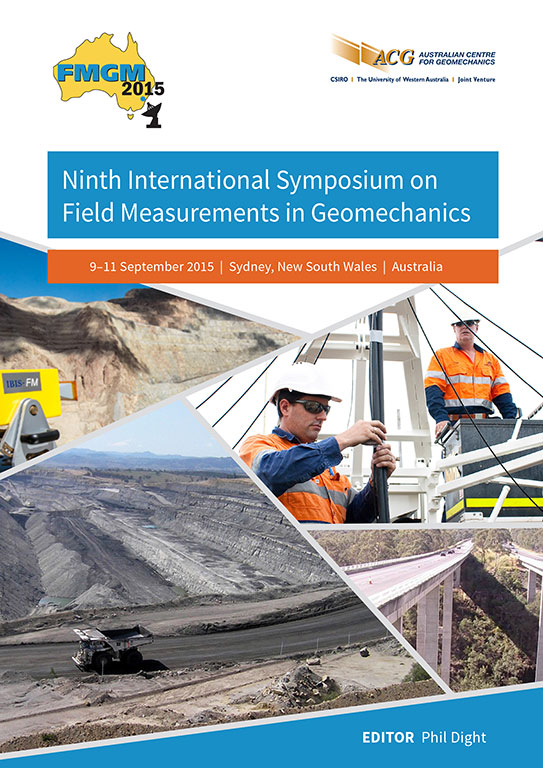Detection of subsidence affecting civil engineering structures by using satellite InSAR

|
Authors: Kauther, R; Schulze, R |
DOI https://doi.org/10.36487/ACG_rep/1508_11_Kauther
Cite As:
Kauther, R & Schulze, R 2015, 'Detection of subsidence affecting civil engineering structures by using satellite InSAR', in PM Dight (ed.), FMGM 2015: Proceedings of the Ninth Symposium on Field Measurements in Geomechanics, Australian Centre for Geomechanics, Perth, pp. 207-218, https://doi.org/10.36487/ACG_rep/1508_11_Kauther
Abstract:
Satellite interferometric synthetic aperture radar (InSAR) is an operational remote sensing technique for monitoring ground deformation. Advanced techniques to process radar data like persistent scatterer interferometry (PS-InSAR) combined with recently available high-resolution radar modes such as StripMap (SM) and spotlight, permit detection and measurement of vertical displacements in a range of sub-centimetre to millimetre and unprecedented ground range resolution. Such features open up new fields of application in civil engineering projects. Now many objects distributed over large areas may be monitored, typically on an object size scale of 2 to 20 m, with high measurement density and adequate accuracy. We present an application of this technique on a navigation lock that was constructed in a karst region where bedrock is locally dissolved by groundwater flow, occasionally leading to sinkholes, surface subsidence and displacement of structures. For that reason, the lock complex has been under terrestrial geodetic survey for several decades. This set of readily available geodetic data has been used to validate the processed satellite InSAR data, acquired by two satellites (ERS and Envisat) during the time period ranging from 1992 to 2010. Encouraged by good agreement of the geodetic and satellite measurements, in a second step TerraSAR-X data taken in SM mode has been processed to increase ground resolution. To assess further improvements in resolution the newly available TerraSAR-X High-Resolution Spotlight (HS) mode is investigated. It can be concluded that InSAR data (ERS and Envisat) reaching back to 1991/1992 may be used to gain information on subsidence effects like using a rear view mirror. However, significant limitations in resolution need to be taken into account. Comparing remotely sensed data using TerraSAR-X (SM) mode to in situ measurements of deformation, it is too early for a 1:1 validation of the very small deformation measured in situ based on 17 months of observation. Nevertheless, it can be stated that no conflicting measurements have been observed and that several areas associated with larger deformations were clearly detected. In our opinion, such approaches may improve the quality of site investigation by focusing further terrestrial geodetic and geotechnical monitoring on such pre-selected locations, especially for operational monitoring of civil engineering applications.
References:
Airbus DS – Infoterra GmbH 2014, ‘Satellitenbasierte Bodenbewegungsmessung in Landau in der Pfalz, Deutschland’, prepared by J Anderssohn, Munich, Germany.
Bateson, L, Novali, F & Cooksley, G 2010, Terrafirma user guide, GMES Terrafirma, viewed 22 May 2015,
Bergholz, K, Kauther, R, Montenegro, H & Straßer, D 2011, ‘Grundwasserinduzierte Veränderungen im lösungsempfindlichen Baugrund unterhalb der Schleusenanlage Hessigheim am Neckar’, Proceedings BAW-Kolloquium — Aktuelle geotechnische Fragestellungen bei Baumaßnahmen an Bundeswasserstraßen, Bundesanstalt für Wasserbau, Karlsruhe, Germany,
pp. 13-26.
BSRSI 1999, ‘Introduction to microwave remote sensing’, prepared by D Lusch, Basic Science and Remote Sensing Initiative, Michigan State University, MA.
Ciampalini, A, Bardi, F, Bianchini, S, Frodella, W, DelVentisette, C, Moretti, S & Casagli, N 2014, ’Analysis of building deformation in landslide area using multisensory PSInSAR technique’, International Journal of Applied Earth Observation and Geoinformation, vol. 33, pp. 166-180.
DLR 2013, TerraSAR-X ground segment basic product specification document, DLR, Cologne, viewed 22 May 2015,
DMV 2013, Grundsätze zum Einsatz von satellitengestützten Verfahren der Radarinterferometrie zur Erfasssung von Höhenänderungen, Deutscher Markscheider-Verein e.V. (DMV), viewed 18 November 2013,
Ferretti, A 1997, ‘Generazione di mappe altimetriche da osservazioni SAR multiple’, PhD thesis, Politecnico di Milano.
Ferretti, A, Monti-Guarnieri, A, Prati, C & Rocca, F 2007, InSAR principles: guidelines for SAR interferometry processing and interpretation (TM-19), European Space Agency ESA Publications, Noordwijk, Netherlands.
Fornaro, G, Reale, D & Verde, S 2013, ‘Bridge thermal dilation monitoring with millimeter sensitivity via multidimensional SAR imaging’, IEEE Geoscience and Remote Sensors Letters, vol. 10, no. 4, pp. 677-681.
Gernhardt, S, Cong, X, Eineder, M, Hinz, S & Bamler, R 2012, ‘Geometrical fusion of multitrack PS point clouds’, IEEE Geoscience and Remote Sensors Letters, vol. 9, no. 1, pp. 38-42.
Jackson, C & Apel, J (eds) 2004, Synthetic aperture radar marine user’s manual, US Dept. of Commerce and National Oceanic and Atmospheric Administration (NOAA), Washington DC.
Kampes, B 2006, ‘Radar interferometry: persistent scatterer technique’, Springer Science + Business Media B.V., Dordrecht, Netherlands.
Ketelaar VBH 2009, ‘Satellite Radar Interferometry – Subsidence Monitoring Techniques’, Remote Sensing and Digital Image Processing, Springer Science + Business Media B.V., Dordrecht, Netherlands.
Lubitz, C, Motagh, M, Wetzel, H & Kaufmann, H 2013, ‘Remarkable urban uplift in Staufen im Breisgau, Germany: observations from TerraSAR-X InSAR and leveling from 2008 to 2011’, Remote Sensing, vol. 5, no. 6, pp. 3082-3100.
Mark, P, Niemeier, W, Schindler, S, Blome, A, Heek, P, Krivenko, A & Ziem, E 2012, ‘Radarinterferometrie zum Setzungsmonitoring beim Tunnelbau‘, Bautechnik, vol. 89, no. 11, pp. 764-776.
Mittermayer, J, Wollstadt, S, Prats-Iraola, P & Scheiber, R 2014, ‘The TerraSAR-X staring spotlight concept‘, IEEE Transactions on Geoscience & Remote Sensing, vol. 52, no. 6, pp. 3695-3706.
Reale, D, Fornaro, G, Pauciullo, A, Zhu, X & Bamler, R 2011, ‘Tomographic imaging and monitoring of buildings with very high resolution SAR data’, IEEE Geoscience and Remote Sensing Letters, vol. 8, no. 4, pp. 661-665.
Schouten, M 2013, ‘Hessigheim-Besigheim sluice complexes in der Neckar River — first results of high-resolution deformation monitoring 2013-2014’, unpublished report by Hansje Brinker BV, Delft.
Schouten, M & Leezenberg, PB 2012, ‘InSAR deformation measurements of the Hessigheim waterway complex (1992-2010)’ unpublished report by Hansje Brinker BV, Delft.
© Copyright 2025, Australian Centre for Geomechanics (ACG), The University of Western Australia. All rights reserved.
View copyright/legal information
Please direct any queries or error reports to repository-acg@uwa.edu.au
View copyright/legal information
Please direct any queries or error reports to repository-acg@uwa.edu.au